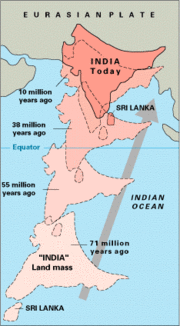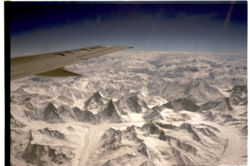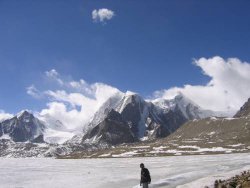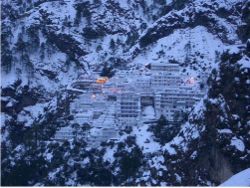Himalayas
2007 Schools Wikipedia Selection. Related subjects: Geography of Asia
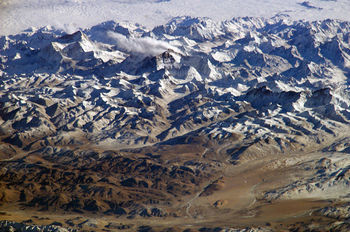
The Himalayas, also Himalaya, are a mountain range in Asia, separating the Indian subcontinent from the Tibetan Plateau. By extension, it is also the name of the massive mountain system which includes the Himalaya proper, the Karakoram, the Hindu Kush, and a host of minor ranges extending from the Pamir Knot. The name is from Sanskrit himālaya, a tatpurusa compound meaning "the abode of snow" (from hima "snow", and ālaya "abode"; see also Himavat).
Together, the Himalaya mountain system is the planet's highest and home to all fourteen of the world's highest peaks: the Eight-thousanders, including Mount Everest. To comprehend the enormous scale of Himalayan peaks, consider that Aconcagua, in the Andes, at 6,962 m, is the highest peak outside the Himalaya, while the Himalayan system has over 100 separate mountains exceeding 7,200 meters.
The Himalayas stretch across six nations: Bhutan, China, India, Nepal, Pakistan and Afghanistan. It is the source of three of the world's major river systems, the Indus Basin, the Ganga- Brahmaputra Basin and the Yangtze Basin. An estimated 750 million people live in the watershed area of the Himalayan rivers, which also includes Bangladesh.
Geography
The Himalaya range runs for about 2,400 km, from Nanga Parbat (Pakistan) in the west to Namche Barwa in the east. The width varies between 250-300 km. The Himalayan range comprises three parallel ranges, arranged by elevation and geological age.
The youngest of the three is called the Sub-Himalayan Range ( Shivalik Hills) and has an elevation of about 1,200 m. This range is made up of erosion material from the rising Himalaya. Running parallel to this is the Lower Himalayan Range, which has an elevation between 2,000–5,000 m. The northernmost range is called the Great Himalayas and is also the oldest of the three. It has an elevation of more than 6,000 m and contains a large number of the world's highest peaks including the three highest, Mount Everest, K2 and Kangchenjunga. Much of Nepal and Bhutan lies in the Himalaya. The Pakistani states of Baltistan and Indian states of Jammu and Kashmir, Himachal Pradesh, Uttaranchal, Sikkim and Arunachal Pradesh lie mostly in the Himalaya. A very small portion of southeastern Tibet also lies in the Himalaya. (However, the Tibetan Plateau is by definition beyond the Himalaya, and thereby not part of it). It is in fact just north of India and Bangladesh.
Ecology
The flora and fauna of the Himalayas varies with climate, rainfall, altitude, and soils. The climate ranges from tropical at the base of the mountains to permanent ice and snow at the highest elevations. The amount of yearly rainfall increases from west to east along the front of the range. This diversity of climate, altitude, rainfall and soil conditions generates a variety of distinct plant and animal communities, or ecoregions.
Lowland forests
On the Indo-Gangetic plain at the base of the mountains, an alluvial plain drained by the Indus and Ganges-Brahmaputra river systems, vegetation varies from west to east with rainfall. The xeric Northwestern thorn scrub forests occupy the plains of Pakistan and the Indian Punjab. Further east lie the Upper Gangetic plains moist deciduous forests of Uttar Pradesh and Lower Gangetic plains moist deciduous forests of Bihar and West Bengal. These are monsoon forests, with drought-deciduous trees that lose their leaves during the dry season. The moister Brahmaputra Valley semi-evergreen forests occupy the plains of Assam.
The Terai belt
Above the alluvial plain lies the Terai strip, a seasonally marshy zone of sand and clay soils. The Terai has higher rainfall than the plains, and the downward-rushing rivers of the Himalaya slow down and spread out in the flatter Terai zone, depositing fertile silt during the monsoon season and receding in the dry season. The Terai has a high water table, and the central part of the Terai belt is occupied by the Terai-Duar savanna and grasslands, a mosaic of grasslands, savannas, deciduous and evergreen forests that includes some of the world's tallest grasslands. The grasslands of the Terai belt are home to the Indian Rhinoceros (Rhinoceros unicornis).
The Bhabhar belt
Above the Terai belt is an upland zone known as the Bhabhar, with porous and rocky soils, made up of debris washed down from the higher ranges. The Bhabhar and the lower Siwalik ranges have a subtropical climate. The Himalayan subtropical pine forests occupy the western end of the subtropical belt, with forests dominated by Chir Pine (Pinus roxburghii). The central part of the range is home to the Himalayan subtropical broadleaf forests, dominated by sal (Shorea robusta).
Montane forests
At the middle elevations of the range, the subtropical forests yield to a belt of temperate broadleaf and mixed forests, with the Western Himalayan broadleaf forests at the western end of the range, and the Eastern Himalayan broadleaf forests in Assam and Arunachal Pradesh. Above the broadleaf forests are the Western and Eastern Himalayan subalpine conifer forests.
Alpine shrub and grasslands
Above the tree line are the Northwestern, Western, and Eastern Himalayan alpine shrub and meadows, which yield to tundra in the higher Himalayan range. The alpine meadows are the summer habitat of the endangered Snow Leopard (Uncia uncia). The highest reaches of the range are above the permanent snow line.
Origins and growth
The Himalayas are among the youngest mountain ranges on the planet. According to the modern theory of plate tectonics, their formation is a result of a continental collision or orogeny along the convergent boundary between the Indo-Australian Plate and the Eurasian Plate. The collision began in the Upper Cretaceous period about 70 million years ago, when the north-moving Indo-Australian Plate, moving at about 15 cm/year, collided with the Eurasian Plate. By about 50 million years ago this fast moving Indo-Australian plate had completely closed the Tethys Ocean, whose existence has been determined by sedimentary rocks settled on the ocean floor and the volcanoes that fringed its edges. Since these sediments were light, they crumpled into mountain ranges rather than sinking to the floor. The Indo-Australian plate continues to be driven horizontally below the Tibetan plateau, which forces the plateau to move upwards. The Arakan Yoma highlands in Myanmar and the Andaman and Nicobar Islands in the Bay of Bengal were also formed as a result of this collision.
The Indo-Australian plate is still moving at 67 mm/year, and over the next 10 million years it will travel about 1,500 km into Asia. About 2 cm/year of the India-Asia convergence is absorbed by thrusting along the Himalaya southern front. This leads to the Himalayas rising by about 5 mm/year, making them geologically active. The movement of the Indian plate into the Asian plate also makes this region seismically active, leading to earthquakes from time to time.
Glaciers and river systems
The Himalayan range encompasses a very large number of glaciers, notable among which is the Siachen Glacier, the largest in the world outside the polar region. Some of the other more famous glaciers include the Gangotri and Yamunotri ( Uttaranchal), Nubra, Biafo and Baltoro ( Karakoram region), Zemu (Sikkim) and Khumbu glaciers (Mount Everest region).
The higher regions of the Himalayas are snowbound throughout the year in spite of their proximity to the tropics, and they form the sources for several large perennial rivers, most of which combine into two large river systems:
- The western rivers combine into the Indus Basin, of which the Indus River is the largest. The Indus begins in Tibet at the confluence of Sengge and Gar rivers and flows southwest through Pakistan to the Arabian Sea. It is fed by the Jhelum, the Chenab, the Ravi, the Beas, and the Sutlej rivers, among others.
- Most of the other Himalayan rivers drain the Ganga-Brahmaputra Basin. Its two main rivers are the Ganges and the Brahmaputra. The Ganga originates as the Bhagirathi from the Gangotri glacier and flows southeast through the plains of northern India, fed by the Alaknanda and the Yamuna among other tributaries. The Brahmaputra originates as the Tsangpo in western Tibet, and flows east through Tibet and west through the plains of Assam. The Ganga and the Brahmaputra meet in Bangladesh, and drain into the Bay of Bengal through the world's largest river delta.
The eastern-most Himalayan rivers feed the Ayeyarwady River, which originates in eastern Tibet and flows south through Myanmar to drain into the Andaman Sea.
The Salween, Mekong, the Yangtze and the Huang He (Yellow River) all originate from parts of the Tibetan plateau that are geologically distinct from the Himalaya mountains, and are therefore not considered true Himalayan rivers. Some geologists refer to all the rivers collectively as the circum-Himalayan rivers
In recent years scientists have monitored a notable increase in the rate of glacier retreat across the region as a result of global climate change. Although the effect of this won't be known for many years it potentially could mean disaster for the hundreds of thousands of people that rely on the glaciers to feed the rivers of northern India during the dry seasons.
Lakes
The Himalaya region is dotted with hundreds of lakes. Most lakes are found at altitudes of less than 5,000 m, with the size of the lakes diminishing with altitude. The largest lake is the Pangong t'so, which is spread across the border between India and Tibet. It is situated at an altitude of 4,600 m, and is 8 km wide and nearly 134 km long. A notable high (but not the highest) lake is the Gurudogmar in North Sikkim at an altitude of 5,148 m (16,890 feet) (altitude source: SRTM). Other major lakes include the Tsongmo lake, near the Indo-China border in Sikkim.
The mountain lakes are known to geographers as tarns if they are caused by glacial activity. Tarns are found mostly in the upper reaches of the Himalaya, above 5,500 metres. For more information about these, see here.
Impact on climate
The Himalayas have a profound effect on the climate of the Indian subcontinent and the Tibetan plateau. It prevents frigid, dry Arctic winds from blowing south into the subcontinent, which keeps South Asia much warmer than corresponding temperate regions in the other continents. It also forms a barrier for the monsoon winds, keeping them from traveling northwards, and causing heavy rainfall in the Terai region. The Himalayas are also believed to play an important part in the formation of Central Asian deserts such as the Taklamakan and Gobi deserts.
The mountain ranges also prevent western winter disturbances from Iran from traveling further, resulting in snow in Kashmir and rainfall for parts of Punjab and northern India. Despite being a barrier to the cold northernly winter winds, the Brahmaputra valley receives part of the frigid winds, thus lowering the temperature in the northeast Indian states and Bangladesh. These winds also cause the North East monsoon during this season for these parts.
The weather phenomenon called Jet Stream in turn affects how we view the highest peaks on earth, as the strong stream of winds from the west often pass through Everest, creating a familiar plume of snows blowing from the summit.
Mountain passes

The rugged terrain of the Himalaya makes few routes through the mountains possible. Some of these routes include:
- Gangtok in Sikkim to Lhasa in Tibet, via the Nathula Pass and Jelepla Passes (offshoots of the ancient Silk Route).
- Bhadgaon in Nepal to Nyalam in Tibet.
- Rohtang Pass in Himachal Pradesh, India.
- The road from Srinagar in Kashmir via Leh to Tibet. This pass is now less used because of regional troubles. Many people are affected.
Impact on politics and culture
The Himalayas, due to their large size and expanse, have been a natural barrier to the movement of people for tens of thousands of years. In particular, this has prevented intermingling of people from the Indian subcontinent with people from China and Mongolia, causing significantly different languages and customs between these regions. The Himalayas have also hindered trade routes and prevented military expeditions across its expanse. For instance, Genghis Khan could not expand his empire south of the Himalayas into the subcontinent.
Himal
Himal is Nepalese for "range" and is used to name the various regions of the Himalayas. In Nepal, these are as follows:
- Sagarmatha Himal
- Annapurna Himal
- Ganesh Himal
- Langtang Himal
- Manaslu Himal
- Rolwaling Himal
- Jugal Himal
- Gauri Sankar Himal
- Kanjirowa Himal
- Khumbu Himal
- Dhaulagiri Himal
Notable peaks
| Peak Name | Other names and meaning | Elevation (m) | Elevation (ft) | First ascent | Notes |
|---|---|---|---|---|---|
| Everest | Sagarmatha -"Forehead of the Sky", Chomolangma or Qomolangma -"Mother of the Universe" |
8,848 | 29,028 | 1953 | World's highest mountain situated on Nepal / Tibet border. |
| K2 | Chogo Gangri | 8,611 | 28,251 | 1954 | World's 2nd highest. Located on border between Pakistan and Xinjiang, China. World's toughest mountain to climb. |
| Kangchenjunga | Kangchen Dzö-nga, "Five Treasures of the Great Snow" | 8,586 | 28,169 | 1955 | World's 3rd highest, highest in India and second highest in Nepal. |
| Makalu | - | 8,462 | 27,765 | 1955 | World's 5th highest situated in Nepal. |
| Cho Oyu | Mt. Zhuoaoyou | 8,201 | 26,906 | 1954 | World's 6th highest situated in Nepal. |
| Dhaulagiri | White Mountain | 8,167 | 26,764 | 1960 | World's 7th highest situated in Nepal. |
| Nanga Parbat | Nangaparbat Peak or Diamir, "Naked Mountain" | 8,125 | 26,658 | 1953 | World's 9th highest. Located in Pakistan. Considered one of the world's most dangerous mountains to climb. |
| Annapurna | "Goddess of the Harvests" | 8,091 | 26,545 | 1950 | World's 10th highest situated in Nepal. |
| Nanda Devi | "Bliss-Giving Goddess" | 7,817 | 25,645 | 1936 |
Notable Himalayan explorers and mountaineers
- Heinrich Harrer (1912 – 2006) Austrian mountaineer, author of the book Seven Years in Tibet.
- Nazir Sabir (Pakistani mountaineer) For the first time in the mountaineering history climbed two eight thousanders (Broad Peak & Gasherbrum II) in a single attempt.
- Tenzing Norgay (1914 – 1986) was a Nepalese Sherpa mountaineer, also first to reach summit of Mt. Everest along with Edmund Hillary.
- Sir Edmund Hillary (born 1919) New Zealand mountaineer and explorer, one of the first men to reach the summit of Mount Everest.
- Jerzy Kukuczka (1948-1989) Polish mountaineer, considered one of the greatest mountain climbers of all time. Ascended all fourteen eight-thousanders faster than anybody else, establishing ten new routes.
- Reinhold Messner (born 1944) Italian mountaineer, considered one of the greatest mountain climbers of all time. First man to climb all fourteen eight-thousanders.
- Harish Kapadia, (born 1945) mountaineer and author.
Religion and mythology
Several places in the Himalaya are of religious significance in Hinduism and Buddhism. In Hinduism, the Himalaya have also been personified as the god Himavat, the father of Shiva's consort, Parvati.
- Haridwar, the place where the river Ganga enters the plains.
- Badrinath, a temple dedicated to Vishnu.
- Kedarnath, where one of the 12 Jyotirlingas is located.
- Gaumukh, the source of the Bhagirathi (and hence, by extension, the Ganga), located a few miles above the town of Gangotri.
- Deoprayag, where the Alaknanda and Bhagirathi merge to form the Ganga.
- Rishikesh, has a temple of Lakshmana.
- Mount Kailash, a 6,638 m high peak which is considered to be the abode of the Hindu god Shiva and is also venerated by Buddhists. Lake Manasarowar lies at the base of Mount Kailash, and is the source of the Brahmaputra.
- Amarnath, has a natural Shiva linga of ice which forms for a few weeks each year. Thousands of people visit this cave during these few weeks.
- The Vaishno Devi is a popular shrine among Durga devotees.
- A number of Tibetan Buddhist sites are situated in the Himalaya, including the residence of the Dalai Lama.
- The Yeti is one of the most famous creatures in cryptozoology. It is a large primate-like creature that is supposed to live in the Himalaya. Most mainstream scientists and experts consider current evidence of the Yeti's existence unpersuasive, and the result of hoaxes, legend or misidentification of mundane creatures.
- Shambhala is a mystical city in Buddhism with various legends associated with it. While some legends consider it to be a real city where secret Buddhist doctrines are being preserved, other legends believe that the city does not physically exist and can only be reached in the mental realm.
- Sri Hemkund Sahib - Sikh Gurudwara where Guru Gobind Singh supposedly meditated and achieved enlightenment in a previous incarnation.
The Himalayas in fiction
- Shangri-La is a fictional utopia situated somewhere in the Himalayas, based on the legendary Shambhala. It is described in the novel Lost Horizon, written by the British writer James Hilton in 1933.
- Tintin in Tibet is one of the series of classic comic-strip albums, written and illustrated by Belgian writer and illustrator Hergé, featuring the young reporter Tintin investigating a plane crash in the Gosain Than massif in the Himalayas. ( 1960)
- The Hollywood movie Vertical Limit (2000), is set in the K2 peak of the Himalayas, in Pakistan.
- Several levels of Tomb Raider 2 and one level in Tomb Raider: Legend of the Tomb Raider series are situated in the Himalayas.


